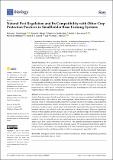Biochar as a feed additive for improving the performance of farm animals
Abstract
Biochar, also known as biomass-derived char or charcoal is a dark/black carbonaceous material generated
from the pyrolysis process under temperature averagely 700 0C and low oxygen levels. Depending on the
intended objectives and conditions of the pyrolysis, the biochar, syngas and bio-oils are the three primary
products generated. The quality of biochar is a function of its primary biomass source, residence time and
temperature during pyrolysis which in turn results in variations of its physicochemical characteristics such
as porosity, carbon content, elemental composition, surface area, retention capacity, and overall applications.
The physical and chemical activation techniques to produce the activated charcoal is often done to improve
the effectiveness of these carbonaceous materials. The biochar has broadly been used globally in agro-
environmental management including in livestock production. Its inclusion at 1 - 3 % of DM of animal feed
rations have been studied to improve health conditions and performance of farm animals such as weight gain,
immunity response, feed intake, feed conversion rates, carcass characteristics and overall quality of animal
products. The mechanisms associated with the beneficial impacts rely on adsorption ability of these materials
in detoxifying the mycotoxins in feed, regulating plant-produced toxins, having a high affinity to pollutants as
well as improvement of the beneficial microbial populations in animals' gastrointestinal tract. However, the
current literature indicates there is still a need for more investigation on the effectiveness of biochar in animal
production due to either limited knowledge or contrasting findings reported. Also, there are imperative
challenges which need to be addressed such as safety standards, specificity, potential contamination,
affordability, and level of awareness by farmers who are end-users of biochar and its products.
URI
: http://doi.org/10.26480/mjsa.02.2020.86.93https://dspace.nm-aist.ac.tz/handle/20.500.12479/1923

